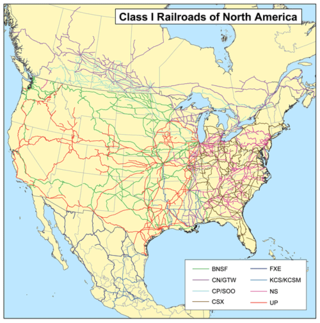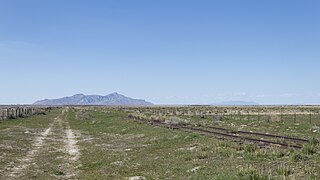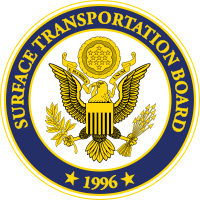
The Interstate Commerce Commission (ICC) was a regulatory agency in the United States created by the Interstate Commerce Act of 1887. The agency's original purpose was to regulate railroads to ensure fair rates, to eliminate rate discrimination, and to regulate other aspects of common carriers, including interstate bus lines and telephone companies. Congress expanded ICC authority to regulate other modes of commerce beginning in 1906. Throughout the 20th century, several of ICC's authorities were transferred to other federal agencies. The ICC was abolished in 1995, and its remaining functions were transferred to the Surface Transportation Board.
The Elkins Act is a 1903 United States federal law that amended the Interstate Commerce Act of 1887. The Act authorized the Interstate Commerce Commission (ICC) to impose heavy fines on railroads that offered rebates, and upon the shippers that accepted these rebates. The railroad companies were not permitted to offer rebates. Railroad corporations, their officers, and their employees, were all made liable for discriminatory practices.

The United States Department of Transportation is one of the executive departments of the U.S. federal government. It is headed by the secretary of transportation, who reports directly to the president of the United States and is a member of the president's Cabinet.

The Staggers Rail Act of 1980 is a United States federal law that deregulated the American railroad industry to a significant extent, and it replaced the regulatory structure that had existed since the Interstate Commerce Act of 1887.
The Railroad Revitalization and Regulatory Reform Act of 1976, often called the "4R Act," is a United States federal law that established the basic outlines of regulatory reform in the railroad industry and provided transitional operating funds following the 1970 bankruptcy of Penn Central Transportation Company. The law approved the "Final System Plan" for the newly created Conrail and authorized acquisition of Northeast Corridor tracks and facilities by Amtrak.
Railbanking is the practice of preserving rail corridors for possible future use. Railbanking leaves the railroad, railbed, bridges or bridge corridor, and other infrastructure intact. This relieves the railroad's operator from the responsibility of maintenance, and from taxation. Existing rails may or may not be maintained intact on the railbed, depending on their condition or any planned interim use of the railbed. Often the rail corridor is put in custody of a state transportation agency, which then seeks a new operator for possible rehabilitation or reactivation. This helps ensure the possibility of future restored rail service when new economic conditions may warrant resuming operation.
In the United States government, independent agencies are agencies that exist outside the federal executive departments and the Executive Office of the President. In a narrower sense, the term refers only to those independent agencies that, while considered part of the executive branch, have regulatory or rulemaking authority and are insulated from presidential control, usually because the president's power to dismiss the agency head or a member is limited.

Railroad classes are the system by which freight railroads are designated in the United States. Railroads are assigned to Class I, II or III according to annual revenue criteria originally set by the Surface Transportation Board in 1992. With annual adjustments for inflation, the 2019 thresholds were US$504,803,294 for Class I carriers and US$40,384,263 for Class II carriers.

The Safety Appliance Act is a United States federal law that made air brakes and automatic couplers mandatory on all trains in the United States. It was enacted on March 2, 1893, and took effect in 1900, after a seven-year grace period. The act is credited with a sharp drop in accidents on American railroads in the early 20th century.
The Office of Economics, Environmental Analysis, and Administration (OEEAA) is a part of the Surface Transportation Board of the United States Department of Transportation, a United States government agency. It does work related to railroads.

The Midland Railway was a heritage railroad operating 16 miles of line in Franklin County and Douglas County in Kansas between Ottawa, Kansas and Baldwin City, Kansas.

The Dakota, Minnesota and Eastern Railroad is a wholly owned U.S. subsidiary of the Canadian Pacific Kansas City. Before its purchase, it was the largest Class II railroad in the United States, operating across South Dakota and southern Minnesota in the Northern Plains of the United States. Portions of the railroad also extended into Wyoming, Nebraska, Iowa, and Illinois. It interchanged with all seven U.S. Class I railroads.

Pan Am Railways, Inc. (PAR) is a subsidiary of CSX Corporation that operates Class II regional railroads covering northern New England from Mattawamkeag, Maine, to Rotterdam Junction, New York. Pan Am Railways is primarily made up of former Class II regional railroads such as Boston and Maine Corporation, Maine Central Railroad Company, Portland Terminal Company, and Springfield Terminal Railway Company. It was formerly known as Guilford Transportation Industries and was also known as Guilford Rail System. Guilford bought the name, colors, and logo of Pan American World Airways in 1998.

The Interstate Commerce Act of 1887 is a United States federal law that was designed to regulate the railroad industry, particularly its monopolistic practices. The Act required that railroad rates be "reasonable and just," but did not empower the government to fix specific rates. It also required that railroads publicize shipping rates and prohibited short haul or long haul fare discrimination, a form of price discrimination against smaller markets, particularly farmers in Western or Southern Territory compared to the official Eastern states. The Act created a federal regulatory agency, the Interstate Commerce Commission (ICC), which it charged with monitoring railroads to ensure that they complied with the new regulations.
United States v. Students Challenging Regulatory Agency Procedures (SCRAP), 412 U.S. 669 (1973), was a landmark decision of the United States Supreme Court in which the Court held that the members of SCRAP—five law students from the George Washington University Law School—had standing to sue under Article III of the Constitution to challenge a nationwide railroad freight rate increase approved by the Interstate Commerce Commission (ICC). SCRAP was the first full-court consideration of the National Environmental Policy Act (NEPA). The Court also reversed the lower court decision that an injunction should be issued at the suspension stage of the ICC rate proceeding. The standing decision has retained its place as the high mark in the Court's standing jurisprudence.
The Youngstown and Southeastern Railroad is a short-line railroad subsidiary of Midwest & Bluegrass Rail that operates freight trains between Youngstown, Ohio and Darlington, Pennsylvania, United States. The line is owned by the Columbiana County Port Authority, leased to the Eastern States Railroad, which is owned by the line's primary shipper, and contracted out to the YSRR. Freight is interchanged with CSX Transportation and the Norfolk Southern Railway at the Youngstown end.

Martin Jay Oberman is an American government official and attorney who served as a member of the Surface Transportation Board (STB) from 2019 to 2024 and as STB chair from 2021 to 2024. He previously served as the chair of the board of directors at Metra, the Chicago commuter rail system.

Karen Jean Hedlund is an American attorney and governmental advisor who has served as a member of the Surface Transportation Board since January 2022.
Transportation in the United States is governed by laws and regulations of the federal government. The Department of Transportation is responsible for carrying out federal transportation policy, and the Department of Homeland Security is responsible for security in transportation.

The Savage Tooele Railroad is a shortline railroad under construction along the former Western Pacific Railroad Warner Branch, to the Lakeview Business Park in Grantsville, Utah. The railroad is approximately 11 miles long. Authorization from the Surface Transportation Board to build the railroad was given in April 2024.













